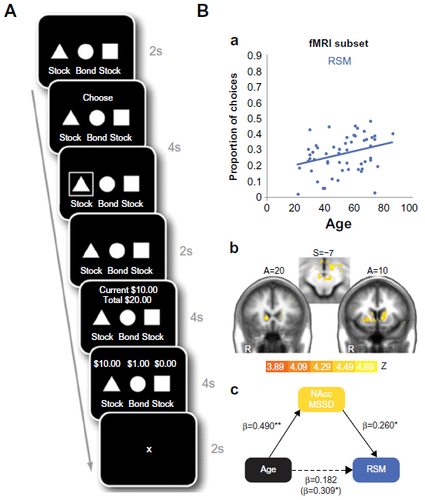Notes: (
A) During each trial, participants saw two stocks and a bond and were subsequently prompted to choose one from the three options. Following a waiting phase, the outcome of the current choice as well as those of the other two options were displayed as gain or loss of different amounts of US $. The bond always gave a small reward and constituted a safe response. Both stocks gave a probabilistic reward and punishment, thus were more risky. However, one stock was “good” and led to higher probability of gain than loss, whereas the other was “bad” and led to higher chance of loss than gain. Stock allocation was performed at the start of each ten-trial block. Participants were not told about which stock was allocated as good or bad and had to work this out themselves through performing. (
B) (
a) Age showed a positive relationship with the frequency of risk-seeking mistakes, or selecting a stock when the rational choice should be the bond. (
b) Age showed a positive relationship with temporal variability of neural signals in midbrain, ventral striatum (nucleus accumbens), and caudate regions. (
c) The positive relationship between age and risk-seeking mistakes was mediated by temporal variability of nucleus accumbens signals. Adapted with permission of the Society for Neuroscience, from Variability in nucleus accumbens activity mediates age-related suboptimal financial risk taking. Samanez-Larkin GR, Kuhnen CM, Yoo DJ, Knutson B. 2010;30(4):1426–1434; permission conveyed through Copyright Clearance Center, Inc.
Citation133Abbreviations: fMRI, functional magnetic resonance imaging; MSSD, mean squared successive difference; NAcc, nucleus accumbens; RSM, risk-seeking mistakes.


